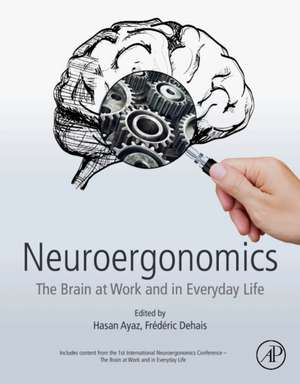Neuroergonomics: The Brain at Work and in Everyday Life
Editat de Hasan Ayaz, Frederic Dehaisen Limba Engleză Paperback – 29 noi 2018
With the advent of new and improved tools that allow monitoring of brain activity in the field and better identification of neurophysiological markers that can index impending overload or fatigue, this book is a timely resource on the topic.
- Includes neurobiological models to better understand risky decision-making and cognitive countermeasures, augmented cognition, and brain stimulations to enhance performance and mitigate human error
- Features innovative methodologies and protocols using psychophysiological measurements and brain imaging techniques in realistic operational settings
- Discusses numerous topics, including cognitive performance in psychological and neurological disorders, brain computer interfaces (BCI), and human performance monitoring in ecological conditions, virtual reality, and serious gaming
Preț: 478.44 lei
Preț vechi: 611.46 lei
-22% Nou
Puncte Express: 718
Preț estimativ în valută:
91.56€ • 95.47$ • 76.10£
91.56€ • 95.47$ • 76.10£
Carte tipărită la comandă
Livrare economică 14-28 martie
Preluare comenzi: 021 569.72.76
Specificații
ISBN-13: 9780128119266
ISBN-10: 0128119268
Pagini: 366
Dimensiuni: 216 x 276 x 19 mm
Greutate: 0.93 kg
Editura: ELSEVIER SCIENCE
ISBN-10: 0128119268
Pagini: 366
Dimensiuni: 216 x 276 x 19 mm
Greutate: 0.93 kg
Editura: ELSEVIER SCIENCE
Public țintă
Neuroscientists, neurobiologists, psychologists, cognitive neuroscientists, neurophysiologists, computer scientists, graduate students, and post-doctoral fellowsCuprins
Introduction
1. Progress and Direction in Neuroergonomics
Methods
2. Electroencephelography for Neuroergonomics
3. Functional Near Infrared Spectroscopy for Neuroergonomics
4. Why is eye-tracking an essential part of Neuroergonomics?
5. The use of tDCS and rTMS methods in Neuroergonomics
6. Brain Computer Interfaces for Neuroergonomics
7. Transcranial Doppler Sonography for Neuroergonomics
8. Simulators and Behavioral Research Methods for Neuroergonomics
9. Neuroergonomics for Aviation
10. MoBI – Mobile Brain Body Imaging
11. Experiments with participants: Some ethical considerations
Neuroadaptive Interfaces and Operator Assessment
12. Measuring the Redline for Mental Overload Using EEG and fNIRS: A Role for Neural Efficiency?
13. Drowsiness Detection during Driving Task Using fNIRS
14. Neuroergonomic Multimodal Neuroimaging During a Simulated Aviation Pursuit Task
15. Is Mindfulness Helping the Brain to Drive?
16. Tracking Team Mental Workload by Multimodal Measurements in The Operating Room
17. Towards Brain-Based Interaction Between Humans and Technology: Does Age Matter?
18. Curvilinear Basis for Cognitive Load State Classification
19. Computational Models for Near Real-Time Performance Predictions Based on Physiological Measures of Workload
20. Mental Workload Assessment as Taxonomic Tool for Neuroergonomics
21. Preliminary Validation of an Adaptive Tactical Training Model: Cognitive Alignment with Performance Targeted Training Intervention Model
Neurostimulation Applications
22. Concurrent fNIRS and TMS for Neurocognitive Enhancement on a Speed of Processing Task
23. Neuromodulatory Effects of Transcranial Direct Current Stimulation Revealed by Functional Magnetic Resonance Imaging
24. Neurophysiological Correlates of tDCS-induced Modulation of Cortical Sensorimotor Networks: A Simultaneous fNIRS-EEG study
25. The use of Online/Offline Terminology for Transcranial Direct Current
Emerging Applications in Decision-making, Usability, Trust and Emotions
26. Neural Signatures of Advice Utilization During Human-Machine Agent Interactions: Functional Magnetic Resonance Imaging and Effective Connectivity Evidence
27. Psychophysical Equivalence of Static Versus Dynamic Stimuli in a Two Alternative Forced Choice Detection Task
28. Functional Near Infrared Spectroscopy: Proof of Concept for its Application in Social Neuroscience
29. Quantifying Brain Hemodynamics during Neuromuscular Fatigue
30. The Assessment of Emotions and Decision Making in Everyday Living Using fNIRS
31. Web Usability Testing with Concurrent fNIRS and Eye Tracking
32. Hybrid Collaborative Brain-Computer Interfaces to Augment Group Decision Making
33. How to Recognize Emotion Without Signal Processing: An Application of Convolutional Neural Network to Physiological Signals
Entries from the Inaugural International Neuroergonomics Conference
1. Progress and Direction in Neuroergonomics
Methods
2. Electroencephelography for Neuroergonomics
3. Functional Near Infrared Spectroscopy for Neuroergonomics
4. Why is eye-tracking an essential part of Neuroergonomics?
5. The use of tDCS and rTMS methods in Neuroergonomics
6. Brain Computer Interfaces for Neuroergonomics
7. Transcranial Doppler Sonography for Neuroergonomics
8. Simulators and Behavioral Research Methods for Neuroergonomics
9. Neuroergonomics for Aviation
10. MoBI – Mobile Brain Body Imaging
11. Experiments with participants: Some ethical considerations
Neuroadaptive Interfaces and Operator Assessment
12. Measuring the Redline for Mental Overload Using EEG and fNIRS: A Role for Neural Efficiency?
13. Drowsiness Detection during Driving Task Using fNIRS
14. Neuroergonomic Multimodal Neuroimaging During a Simulated Aviation Pursuit Task
15. Is Mindfulness Helping the Brain to Drive?
16. Tracking Team Mental Workload by Multimodal Measurements in The Operating Room
17. Towards Brain-Based Interaction Between Humans and Technology: Does Age Matter?
18. Curvilinear Basis for Cognitive Load State Classification
19. Computational Models for Near Real-Time Performance Predictions Based on Physiological Measures of Workload
20. Mental Workload Assessment as Taxonomic Tool for Neuroergonomics
21. Preliminary Validation of an Adaptive Tactical Training Model: Cognitive Alignment with Performance Targeted Training Intervention Model
Neurostimulation Applications
22. Concurrent fNIRS and TMS for Neurocognitive Enhancement on a Speed of Processing Task
23. Neuromodulatory Effects of Transcranial Direct Current Stimulation Revealed by Functional Magnetic Resonance Imaging
24. Neurophysiological Correlates of tDCS-induced Modulation of Cortical Sensorimotor Networks: A Simultaneous fNIRS-EEG study
25. The use of Online/Offline Terminology for Transcranial Direct Current
Emerging Applications in Decision-making, Usability, Trust and Emotions
26. Neural Signatures of Advice Utilization During Human-Machine Agent Interactions: Functional Magnetic Resonance Imaging and Effective Connectivity Evidence
27. Psychophysical Equivalence of Static Versus Dynamic Stimuli in a Two Alternative Forced Choice Detection Task
28. Functional Near Infrared Spectroscopy: Proof of Concept for its Application in Social Neuroscience
29. Quantifying Brain Hemodynamics during Neuromuscular Fatigue
30. The Assessment of Emotions and Decision Making in Everyday Living Using fNIRS
31. Web Usability Testing with Concurrent fNIRS and Eye Tracking
32. Hybrid Collaborative Brain-Computer Interfaces to Augment Group Decision Making
33. How to Recognize Emotion Without Signal Processing: An Application of Convolutional Neural Network to Physiological Signals
Entries from the Inaugural International Neuroergonomics Conference
